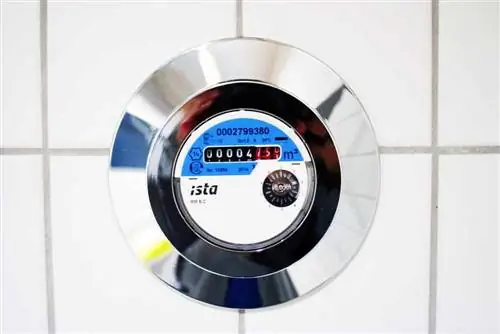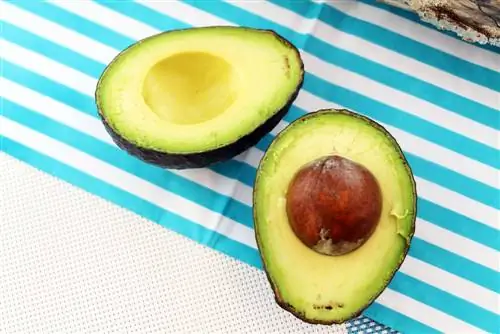- Author admin [email protected].
- Public 2023-12-17 03:39.
- Last modified 2025-01-24 12:45.
In many regions, water meters are read by a field representative commissioned by the local utility company. If you are not at home at the specified time, you have the option of reading the values yourself and sending them in. However, this requires that you know where the water clocks are and how to read the clock correctly.
How the reading should be done
Ideally, the water meter is mounted so that it can be easily viewed. On some models you have to open a flap to read the meter reading. However, it sometimes happens that the water consumption meter is installed in a very unfavorable position or height. Then you need a chair, a step or a small ladder to determine the meter reading. Alternatively, it is also possible to take a front photo with your cell phone and then read the values from the photo. This method is often easier than awkwardly climbing a meter that is in a very awkward position.
How the reading process works
If you know the structure of a water meter, you can safely carry out the reading process. There is a yellow seal on the side to prevent tampering. This seal must be in order. There must be a sticker with the valid calibration date on the side of the window, which must be clearly legible. You should check these two facts before reading the meter. If you discover any discrepancies, you should immediately report them to your local waterworks or supplier.
Various water meters can be installed
There are electronic and mechanical water clocks, but they do not differ in their function. If your meter hasn't been changed in a long time, you will most likely be reading a mechanical meter. You can recognize electronic meters by their digital numbers. The structure is the same for all models. Electronic meters are considered more modern, but not more reliable, so you don't have to worry about a mechanical meter not working properly.
Mechanical water clocks
Many mechanical water clocks have eight wheels. It is important that you read the values correctly to ensure an accurate calculation of your water consumption. Reading a mechanical water clock is easy if all digits are displayed on the eight-digit dial. Alternatively, there are models with a combination of number wheels and up to four small wheels. These show the digits after the decimal point. There is also an engraved series of numbers at the top. This is the meter number. This must always be stated, especially if you read several clocks in the house or apartment.
Display of the digits after the decimal point
Before reading for the first time, you need to find out how the digits after the decimal point are represented. As a rule, water meters show four decimal places. The advantage is that water consumption can be determined precisely. Water consumption is billed in cubic meters. Thanks to the digits after the decimal point, a very precise consumption strategy can be recorded.

Display of the decimal places in the number row
If the decimal places are shown in the number row, differentiate between five places before and three places after the decimal point. For better differentiation, the numbers before the decimal point are shown in black and the numbers after the decimal point are shown in red. This makes it easy to record consumption at a glance. As a rule, these water meters are newer models. The five digits before the decimal point are sufficient for the operating time of the water meters. They are replaced with a new model every seven to eight years. For this reason, it is no longer necessary to display an eight-digit number in conjunction with up to four wheels. The wheels were therefore replaced by the numerical representation. On some water meters you will find a single wheel with the indication x 0. 0001. This is the fourth digit after the decimal point and therefore indicates the consumption in liters.
Representation of the decimal places as cogs
If the decimal places are not included in the row of numbers as red numbers, they are located as cogs below the row of numbers. If you want to read such a water meter, it is a little more difficult. There is a number under the wheel. This can be, for example, x 0, 1. This value is the first digit after the decimal point. Further wheels can be found with the information x 0.01, x 0.001 and x 0.0001. The wheels show a red pointer. This is on a scale that looks similar to a clock. However, only the numbers zero to nine are displayed. Write down the number where the red pointer is currently located.
Electronic water meters
The structure of an electronic water meter is similar. Here, too, there can be several decimal places and the consumption of cold or hot water can be framed. However, there are no wheels that turn, instead the digital numbers jump over.
Abbreviations on water clocks and their meaning
You may sometimes see abbreviations on the water meter. For models installed after 2006, the flow must be specified due to an EU directive (2004/22/EC). This is intended to achieve greater accuracy in the values that the counters output. A distinction is made between:
- Minimum flow Qmin
- Separating flow rate QIsolat
- Nominal flow rate Qn
- Maximum flow Qmax
It is also common to use other designations:
- Qmin as minimum flow Q1
- Qsplitter as transition flow Q2
- Qn as continuous flow Q3
- Qmax as overload flow Q4
Write down the meter reading correctly

After reading, it is important that you write down the meter reading exactly. Your water consumption will be billed based on this meter reading, so if you simply turn the number wrong, you may end up paying more than you used. Send the meter reading to the utility within the specified deadline. Otherwise, the meter reading will be estimated, so you will have to pay a higher deduction.
Calculate the cost of water consumption
The costs for water consumption consist of the fees for running water and the energy costs for heating the water. The water meter records consumption in cubic meters. This is then multiplied by the costs. Energy costs will be added for the amount of hot water you need.
A generally valid calculation of hot water consumption is not possible because the costs vary greatly from region to region. For example, if you live in Berlin, a cubic meter of water costs EUR 1,694. This corresponds to 1.000 liters. Your water meter shows consumption in cubic meters. If you use 700 cubic meters a year, you will pay around 1250 EUR in water costs. The basic fees are included. This roughly corresponds to the average consumption of a family of four in Berlin.






